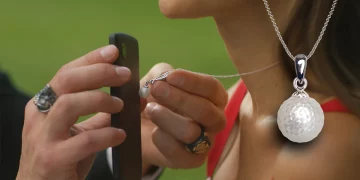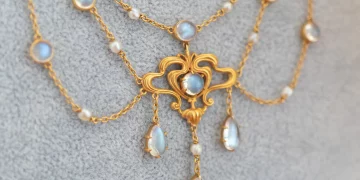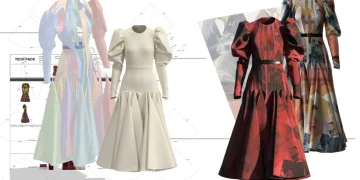The jewelry industry has long been synonymous with timeless craftsmanship and luxury materials, but the world of adornment is evolving at a rapid pace. With each passing year, the boundaries of jewelry design are being pushed further, with innovative materials and cutting-edge techniques taking center stage. As consumers become more sophisticated and demand both sustainability and individuality, jewelry designers are embracing these challenges by adopting novel materials, experimenting with new technologies, and blending traditional craftsmanship with modern innovation.
In this article, we will explore how the latest innovations in materials and craftsmanship are shaping the future of jewelry design and how forward-thinking designers are leading the charge. From the rise of lab-grown diamonds to the use of sustainable metals and 3D printing, these trends are not only changing the way jewelry is made but also the way it’s perceived and valued in today’s market.
1. Embracing Sustainable Materials: Eco-Conscious Jewelry for the Modern Consumer
Sustainability is no longer a buzzword—it’s an imperative. As environmental concerns grow and consumers demand more eco-conscious products, jewelry designers are leading the way in incorporating sustainable materials into their collections. The integration of these materials is revolutionizing the industry and helping to shape a new standard for luxury.
1.1 Lab-Grown Diamonds: Ethical Luxury
One of the most groundbreaking shifts in the jewelry industry is the rise of lab-grown diamonds. These diamonds, created in a lab using high-pressure, high-temperature (HPHT) or chemical vapor deposition (CVD) techniques, are chemically and physically identical to natural diamonds. However, they are significantly more sustainable and ethically sourced.
- Lab-grown diamonds are gaining traction among consumers who are concerned about the ethical and environmental impact of traditional diamond mining. With no need for harmful mining practices, lab-grown diamonds are more eco-friendly and often come with a lower carbon footprint.
- Many high-end jewelry brands are incorporating these diamonds into their designs, proving that ethically sourced luxury is no longer a contradiction. Designers like Tiffany & Co. and De Beers have launched collections featuring lab-grown diamonds, signaling a shift in consumer preferences toward sustainability without sacrificing beauty or elegance.
1.2 Recycled Metals: Closing the Loop in Jewelry Production
In line with the growing focus on sustainability, designers are increasingly turning to recycled metals—such as recycled gold, platinum, and silver—as alternatives to newly mined materials. This closed-loop approach not only conserves resources but also reduces the environmental impact of jewelry production.
- Recycled gold is a particularly popular choice, as it significantly reduces the need for mining and is available in a variety of high-quality forms. Brands like Chopard and Pippo Perez are leading the charge by using recycled metals in their luxury collections, ensuring that craftsmanship and sustainability go hand in hand.
- Designers are also exploring how to use recycled gemstones—such as old diamonds, sapphires, and rubies—by carefully re-cutting and setting them into new pieces. This practice allows them to reimagine and reuse precious stones that may otherwise go to waste, offering clients a chance to own beautifully reimagined heirlooms.
2. The Rise of 3D Printing: Revolutionizing Design and Production
3D printing, also known as additive manufacturing, has been making waves in the jewelry industry, providing designers with unprecedented creative freedom and the ability to produce complex and intricate designs that would otherwise be difficult or impossible to create using traditional techniques.
2.1 Pushing the Limits of Design
In the past, jewelry design was often constrained by the limitations of casting and molding. 3D printing, however, allows designers to create highly detailed and intricate shapes that push the boundaries of creativity and form.
- For example, filigree designs—delicate, lace-like metalwork—can be printed with extreme precision, creating lightweight, yet structurally sound pieces. Designers can experiment with organic shapes, interlocking structures, and geometric patterns, opening up a new world of design possibilities.
- Designers can also test their designs in a virtual space before committing to the production of physical pieces, ensuring that each design is both aesthetically pleasing and technically feasible. This rapid prototyping enables them to produce one-of-a-kind, customized jewelry that caters to the unique preferences of individual clients.
2.2 Reducing Waste and Improving Efficiency
3D printing not only facilitates more complex designs but also offers a significant reduction in material waste. Traditional methods often result in the cutting away of excess metal or gemstone to achieve the desired form, whereas 3D printing creates only the material necessary for the design.
- This leads to a more sustainable approach to jewelry making, with less material discarded in the process. By utilizing precision printing, designers can produce intricate designs with minimal waste, making 3D printing an ideal tool for producing eco-conscious jewelry.

3. Innovating with New Materials: From Smart Jewelry to Biodegradable Pieces
As technology and material science continue to advance, jewelry designers are increasingly experimenting with non-traditional materials to create unique, functional, and futuristic designs. These innovations are allowing designers to create jewelry that goes beyond adornment, incorporating smart technology, biodegradable materials, and other cutting-edge features.
3.1 Smart Jewelry: Combining Fashion with Function
The fusion of fashion and technology is one of the most exciting frontiers in jewelry design. Smart jewelry, which combines traditional craftsmanship with modern tech, is gaining traction as designers incorporate wearable technology into their creations. From fitness trackers to health monitors and smart rings, this sector is expanding rapidly.
- Brands like Oura Ring and MediPedi are designing jewelry that serves dual purposes—functioning as both stylish accessories and health monitors. These items are often equipped with sensors to track biometric data, sleep patterns, and physical activity.
- Designers are also integrating connected elements into their pieces, allowing users to control devices, track their location, or even make contactless payments via their jewelry. This trend is blurring the lines between luxury and technology, paving the way for a new kind of functional adornment.
3.2 Biodegradable Materials: Jewelry for the Future
On the opposite end of the spectrum, some designers are experimenting with biodegradable materials for more eco-conscious pieces. These materials offer the possibility of creating beautiful, organic designs that do not contribute to long-term waste or harm the environment.
- Materials such as bioplastic, natural fibers, and recycled organic matter are being explored for creating sustainable, yet luxurious jewelry that maintains aesthetic appeal while reducing environmental impact.
- The integration of biodegradable materials into high-end designs represents a bold statement about the industry’s potential for sustainability. Designers are working to combine these new materials with traditional techniques, creating pieces that are both innovative and ethically responsible.
4. Traditional Craftsmanship Meets Modern Innovation
While innovation is at the forefront of jewelry design, traditional craftsmanship remains at its core. The fusion of old-world techniques with modern technology allows for the creation of pieces that embody both heritage and cutting-edge innovation.
4.1 Reviving Ancient Techniques with Modern Tools
Jewelry designers are drawing inspiration from ancient craftsmanship techniques—such as filigree, granulation, and stone setting—and incorporating them into modern designs. These time-honored methods, once thought to be outdated, are being re-imagined and enhanced with modern tools and materials.
- By merging traditional handcrafting techniques with 3D modeling and precision tools, designers are able to create complex, detailed pieces that reflect both historical artistry and modern sophistication.
- These methods are not only being used for aesthetic purposes but also to preserve the cultural and artistic significance of ancient jewelry traditions, making them relevant to a new generation of consumers who value both heritage and innovation.
4.2 Personalization and Customization Through Technology
In addition to creating beautiful and sustainable jewelry, designers are also focusing on personalization—a major trend that is taking over the jewelry industry. Using technology like 3D printing, laser engraving, and virtual design consultations, consumers now have the ability to design their own unique pieces.
- From engraving personal messages to customizing designs based on one’s style and preferences, the role of technology in personalization is giving consumers a sense of ownership and individuality.
- By incorporating personalized elements, designers are allowing consumers to create one-of-a-kind, emotionally significant pieces, further elevating the role of jewelry as a personal expression.
Conclusion: The Future of Jewelry Design Is Bold, Sustainable, and Innovative
As the jewelry industry continues to evolve, it is clear that innovative materials and cutting-edge craftsmanship will be at the forefront of shaping the next wave of fashion trends. Whether it’s through the use of lab-grown diamonds, 3D printing, smart jewelry, or biodegradable materials, designers are embracing technology and sustain ability to create pieces that are both functional and beautiful.
As we look to the future, it’s evident that jewelry design will continue to challenge the norms of the industry—offering consumers more personalized, eco-friendly, and forward-thinking pieces. The next generation of jewelry will be defined by the harmonious fusion of traditional craftsmanship, modern innovation, and ethical responsibility, offering us a glimpse of a more sustainable, creative, and dynamic future for the luxury jewelry market.

















































